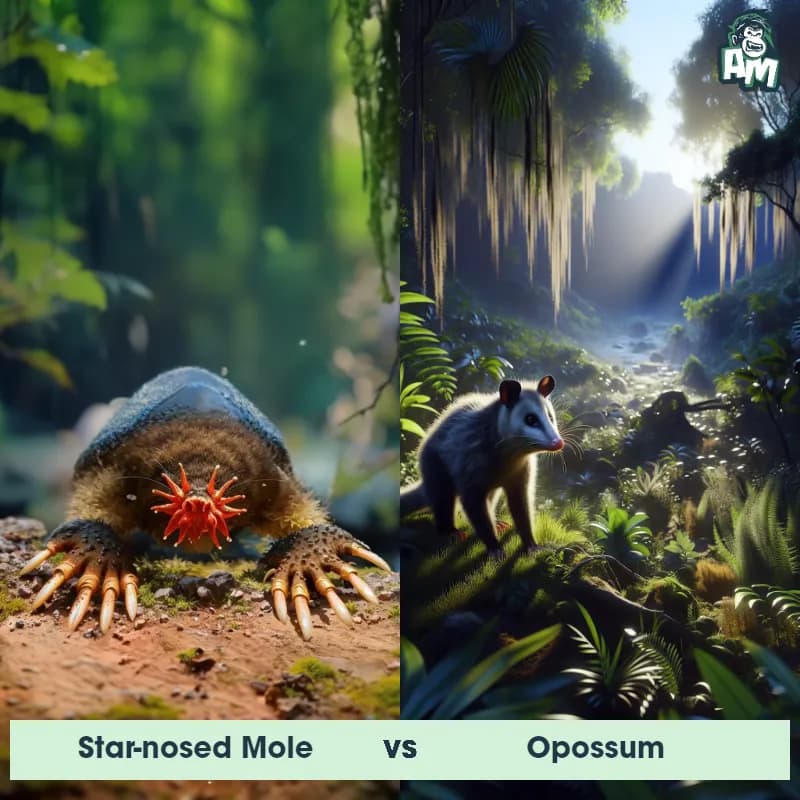Star-Nosed Mole vs OpossumSee Who Wins

Welcome to the three round matchup between these two fierce competitors, the Star-Nosed Mole and the Opossum. Both of these animals are known for their unique skills and abilities, so we can expect an intense battle here tonight.
Contender 1: Star-Nosed Mole
The Star-Nosed Mole, scientifically known as Condylura cristata, is a small mammal found in the wetlands of eastern North America. It is easily recognizable by its unique star-shaped nose, which is used to detect prey. The nose consists of 22 pink fleshy appendages known as "rays," each covered in numerous touch-sensitive sensors called Eimer's organs. This extraordinary nose allows the mole to navigate and forage quickly in dark, aquatic environments. The Star-Nosed Mole has a cylindrical body with dense velvety fur, tiny eyes, and shovel-like claws for efficient digging.
Fun Fact: The Star-Nosed Mole possesses one of the most incredible sensory organs, as it can locate and consume prey in less than a quarter of a second!
Contender 2: Opossum
The Opossum, commonly known as the North American opossum, is a marsupial native to the Americas. They have a distinct appearance with a pointed snout, a hairless prehensile tail, and ears that can range from rounded to pointed. Their fur is coarse and can be gray, brown, or black in color. One remarkable trait of the Opossum is their ability to play dead when threatened, feigning death as a defense mechanism. They are primarily nocturnal creatures, using their keen sense of smell and hearing to locate food and navigate their surroundings.
Fun Fact: The Opossum has an impressive reproductive strategy as they are capable of having up to three litters per year, each consisting of around 15 baby opossums called "joeys." However, not all joeys survive as they have a high mortality rate, and often only a handful of them make it to adulthood.
Matchup Stats
| Star-Nosed Mole | Opossum | |
|---|---|---|
| Size | 6-8 inches (15-20 cm) | Height: 9-13 inches (22.9-33 cm) |
| Weight | 1-2 ounces (30-60 grams) | 1-14 pounds (0.45-6.35 kg) |
| Speed | 3 mph (4.8 km/h) | 4.5 mph (7.24 km/h) |
| Key Strength | Speed and agility | Bite strength |
| Biggest Weakness | Lack of physical strength | Lack of speed/agility |
Current Votes
Star-Nosed Mole vs Opossum
See Who Wins
View More Matches
Looking For More?
Similar Matches
Scientific Stats
| Star-Nosed Mole | Opossum | |
|---|---|---|
| Scientific Name | Condylura cristata | Didelphis virginiana |
| Family | Talpidae | Didelphidae |
| Habitat | Wetlands | Forests, woodlands, and wet areas |
| Geography | Eastern North America | Native to the Americas, including North and Central America |
| Diet | Insects, worms, and small invertebrates | Omnivorous - feeds on fruits, vegetables, insects, small animals, and carrion |
| Lifespan | 4 years - 6 years | 2 years - 4 years |
Key Differences between Star-Nosed Mole and Opossum
- Diet: The Star-Nosed Mole primarily feeds on small invertebrates and insects, using its star-shaped snout to detect prey, whereas the Opossum is omnivorous, consuming fruits, insects, and carrion.
- Body shape: The Star-Nosed Mole has a cylindrical body with short legs and large digging claws, whereas the Opossum has a more elongated body with a long, prehensile tail.
- Habitat: The Star-Nosed Mole is strictly terrestrial, living in underground burrows in wet areas, while the Opossum is arboreal, often found in trees or human habitats.
- Behavior: The Star-Nosed Mole is solitary and active year-round, while the Opossum is more social and nocturnal, known to play dead when threatened.
- Size: The Star-Nosed Mole is much smaller, typically measuring around 6-8 inches in length, while the Opossum is larger, ranging from 15-20 inches long.
- Color: The Star-Nosed Mole has dark brown fur with a distinctive star-shaped pink snout, whereas the Opossum has a grayish-white fur and a long, hairless tail.
































